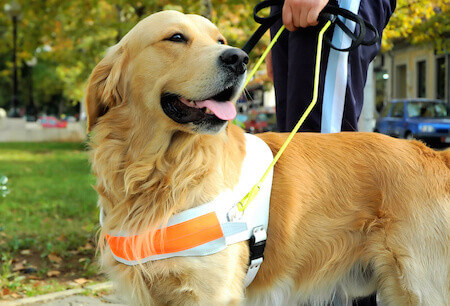Animals have been helping people for a long time. Camels have been used for transport for thousands of years. Dogs have been around to help with hunting for about as long. Mice have been used in laboratories for hundreds of years.
Yet, that’s not a complete list of the animals or how they help. For that, keep reading.
Service Animals | Detection Animals | Animal Assisted Therapy
Service Animals for The Blind & Disabled
In the United States, dogs typically provide services for the blind and disabled. The U.S. has laws establishing the rights of people with service animals, and typically only recognizes dogs. However, in some cases, miniature horses are also recognized. Unfortunately, the Americans with Disabilities Act does not recognize therapy dogs, emotional support dogs, and companion dogs as service animals.
Service animals aren’t required to undergo any official training in the U.S. However, officially recognized training areas will make it easier for people who face many challenges to the use of their service animals in establishments. Service animals are either trained by families or by certified professionals. Certified professionals often introduce service animals into real-world scenarios before being handed to people.
Most commonly, service animals help the blind by leading them through busy city streets and keeping them away from other dangers, such as potholes and manholes, people, and other dangers. For those with disabilities, service dogs sometimes help pull wheelchairs, provide balance, help people with Autism, assist people who suffer from seizures or diabetes.
Learn more about ESA vs Service Animals

Further Reading:
Getting a Dog Service Certified
Dog Care Guide
Detection Animals for Law Enforcement & The Military
Dogs help people find drugs hidden from law enforcement and bombs that have been planted away from sight. Along with dogs, rats help sniff out landmines in other parts of the world. Dolphins have also served the military for many decades now, running surveillance on submarines and floating mines.
These animals go through rigorous training because of the nature of their work. Drug sniffing animals work with different types of drugs and their scents. They’re also trained to avoid diversion scents that are meant to keep the dogs from finding the drugs. Dolphins, rats, and dogs that are trained to find explosives start out with decoys that include the scents of materials used in bombs before they move up to finding actual explosive devices.
These animals help keep people safe from the threats of terrorism and those who use drugs. They help to keep neighborhoods safe where drug dealers can become violent and territorial over parts of cities where they sell. Because they can spot explosives and drugs simply by scent, they keep people out of these dangerous situations.

Animal Assisted Therapy
Animals are often used to provide therapy for people with ADHD, autism, mental disorders, PTSD, depression, and anxiety. Dogs, cats, and horses are used for these situations. They can also help school children, people who have recently lost loved ones, drug addicts, and prisoners.
Horses are especially adept at helping people because they share similar behaviors with people and find it easier to develop connections with individuals. They are great at soothing the stress and anxiety many people feel. Likewise, dogs in classrooms help school children feel safe, as children feel dogs are non-judgmental. The same effect is observed in prisons and drug rehabilitation centers where many of the previous behaviors that people exhibited were partly due to stress, anxiety, and depression.

How successful is animal assisted therapy?
In prison, drug rehabilitation, and elderly settings, animal-assisted therapy has shown greater improvement in treatment and therapy sessions. Although there have been debates about the process of the studies, many of them have shown 90 percent to 100 percent rates of the significant improvement in people treated with animal-assisted therapy.
Prison Inmates
In prisons, animal-assisted therapy showed marked improvement in treating criminal behavior and drug use. It also helped reduce the levels of anxiety, stress, and depression in criminals. These findings were aided by the improvement in social skills exhibited by prisoners during animal-assisted therapy.
Drug Treatment
In those who suffer from drug abuse, animal-assisted therapy not only increased the recovery rates, they also helped people share personal details about their lives. Additionally, studies revealed that people who suffer from drug abuse also have a greater instance in the history of animal abuse. Animal-assisted therapies not only helped those recovering from drug abuse reveal these histories but also helped them learn how to treat animals in a loving manner.
The Elderly
According to studies, animal-assisted therapy can help reduce some of the symptoms of dementia and schizophrenia in elderly patients. Animal-assisted therapy has shown that “Treatment encouraged mobility, interpersonal contact, and communication and reinforced activities of daily living (ADLs), including personal hygiene and independent self-care, through the use of cats and dogs as ‘modeling companions.’” The increase in social interaction reduced the effects of dementia, depression, and suicidal thoughts.
Additional Resources & Organizations
- Vetereran Services
- Assistance Dogs International
- International Guide Dog Federation
- National Association of Guide Dog Users
- Pets for Patriots
More About Service Animals
Can a Rabbit Serve as an Emotional Support Animal?
Emotional support animals (ESAs) have witnessed a surge in popularity, offering invaluable emotional comfort and companionship to those grappling with mental health issues. While dogs and cats are the most conventional choices as ESAs, have you ever considered whether a rabbit can fulfill this role? In this blog post, we will explore the feasibility of ... Read more
Everything You Need to Know About Emotional Support Animals
An emotional support animal also called an assistance animal, helps lessen the symptoms of mental or emotional disorders such as depression, anxiety, and post-traumatic stress disorder. A licensed mental health professional will frequently recommend such aid animals as a part of a patient’s therapy regimen. An official letter known as an emotional support animal letter, ... Read more
What Are the Best Hunting Dog Breeds?
Hunting dogs are extremely helpful for locating and flushing birds; they are also perfect for retrieving downed birds for the hunter. Let’s look at a few of the best bird hunting dog breed, and why they are so perfect for the task. First, we will look at two distinctions between types of hunting dogs, the ... Read more
What Are Good Guard Dog Breeds?
If you’re looking to feel safer in your home or just want a furry friend to watch your property, you could benefit from owning a guard dog. Guard dogs should be loud, tenacious, and protective. They may not be the largest or most intimidating dog in the room, but their drive to protect family comes ... Read more
Reviewed By: Tim Winter

Tim Winter has a strong affection for pets and wildlife. His years of experience caring for various types of pets has led him to share his knowledge with others on the best practices in pet care. Tim holds a Bachelor of Science from the University of Oregon School of Journalism and Communications.
